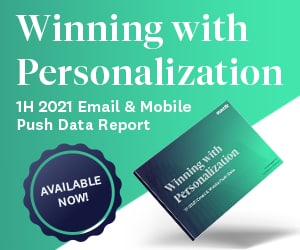 Sep 22, 2021 |
|
Good morning, Marketer, is the NFT the next CDP? I realize that blockchain-based non-fungible tokens are not at all like 360-view customer data platforms. But just a few short years ago, tech journalists like me were still scratching our heads over what the right definition and capabilities of a CDP even were. Fast forward to now, at our recent MarTech conference, and it seemed that CDPs were mentioned in actionable ways by marketers in almost every session. Similarly, the NFT could very well become a part, however big or small, of nearly every marketer’s arsenal. If consumers collect and trade NFTs, and show them off as part of their digital personalities, brands might consider this almost like another social media platform. As adoption grows, this NFT segment of brand love and loyalty will shift demos. Remember when Facebook was for reaching college students and recent grads? In covering the next phase of NFT marketing (the early adoption “novelty” phase concluded at the beginning of the year with Taco Bell), I checked in with Chris Georgen, founder and Chief Architect of Topl, which uses blockchain technology to help businesses measure value chains. Chris suggested, in these early stages, that there is also a data advantage for brands to use loyalty programs with NFTs because they wouldn’t be sharing customer data with third parties or relying on them for their data. Instead, the data from the customers’ interaction with the NFTs is all recorded in the blockchain. Georgen anticipates that this would provide better access and flexibility to marketers to segment and engage their customers. Maybe NFTs are more like CDPs than we might have thought. However, it’s still early stages. Chris Wood,
Editor |
|
| | | Section | | | | | Burger King is getting real with NFTs | | Last week, QSR chain Burger King launched an NFT-based sweepstakes around their BK Keep It Real Meals. The promotion is designed and supported by NFT marketplace Sweet with a focus on experience and easy adoption of the technology. The payoff could have implications for many brands looking to cash in on interest in collectible NFTs and to crack the code of how to use blockchain technology to encourage sustainable consumer attention and engagement. It comes down to experience. “At Burger King, the guest experience is at the core of everything we do, and we’re always looking for innovative ways to engage with our guests,” said a Burger King spokesperson. “The BK Keep It Real Meals campaign felt like a natural fit to launch this kind of large-scale NFT-based game that would allow guests to engage with our brand and this campaign in a unique, culturally relevant way.” “It’s like getting a toy in the box, but it’s a digital toy,” said Tom Mizzone, CEO and founder of Sweet. Customers order one of three Keep It Real Meals curated by pop artists Nelly, Anitta and LILHUDDY. They scan the QR code on the meal box with their phone, download the Sweet app, and receive a collectible NFT game piece. Every 12 hours they can scan the box again to receive a new game piece, keeping the participants glued to the game. Read more here. |
|
| | | | What clients need from your marketing agency today | | There’s never been a better time to be an agency. After a rocky 18 months, 80% of small-to-midsize businesses (SMBs) say they’ve recovered from the impacts of COVID-19 – and nearly half (43%) say they plan to invest more money into developing marketing strategies over the next year. But that’s not all. A full 94% want to hire external agencies to help improve their marketing efforts as pandemic restrictions get lifted, and 96% of those businesses said they are open to paying their agencies more. Yes, you heard that right – they’re even willing to pay more for certain services. Read More » |
|
| | | Performance | | | | | iOS 15 and letting go of open rates | | RPEOrigin.com co-founder Ryan Phelan has a lot to say about “Pixelgeddon” – also known as Apple’s Mail Privacy Protection feature, which went into effect on Monday, Sept. 20. The best thing he sees coming out of it is that he will never have to listen to another conference speaker tell his audience, “It’s all about the opens.” As of Monday, the thing many email marketers have dreaded – iOS 15 – has launched, which will nullify tracking on emails opened by Apple Mail users and makes the open rate even less reliable. It’s a day of rejoicing for those like Ryan who have advised marketers for years not to over-value the open rate. It also fulfills the warnings made long ago when fewer people were listening. It comes down to tactics versus strategy. Tactically, opens fueled automation and inferred intent. But strategically, we know deep down in the confessional at the Marking Automation church that the open rate (for the most part) doesn’t mean crap. From a strategic standpoint, clicks and associated behavior on the website are better indicators of intent than opens. Read more here. |
|
| | | | Webinar Tomorrow: Your customer has evolved. So should your marketing. | | Digital-first no longer means email-first. Marketers must move beyond a single-channel marketing approach to reach B2B buyers where they are – in all channels. Join our experts as they share strategies to connect and build trust with your buyers, including how to target and identify known and unknown buyers, orchestrate cross-channel campaigns quickly and precisely, and build trust with buyers by ensuring all data is standardized, valid, compliant and marketable. RSVP Today » |
|
| | | Transformation | | | | | BIMI: the new standard for email marketing? | | Brand identifiers for message identification, or BIMI, is a technology that some expect to become a new standard for email marketing. And for good reason; BIMI offers capabilities that provide higher levels of customer trust and engagement with brands. “BIMI is a brand-supported logo within supporting email clients,” said Danielle Gallant, Email Strategist at Validity, speaking at MarTech. “BIMI is a critical tool for marketers now because it is a low-cost marketing strategy that increases brand recognition and really helps to build trust between the brand and its audience.” Google started rolling out BIMI support in Gmail in July 2021, and other email platforms are expected to follow. By ensuring brand logos are appended to verified emails, BIMI helps marketers better connect with customers. It also verifies your outgoing emails to prevent fraud, displaying the brand logo next to only authenticated messages. “BIMI is great because it serves two purposes,” Gallant said. “It pleases the mailbox providers, which now includes Gmail, and also the subscribers, who we’re always trying to cater to by building that brand awareness and trust.” Read more here. |
|
| | | | Available on-demand: 75+ sessions, solutions, and case studies for senior marketers | | The entire MarTech program is now ready for you to watch on-demand, featuring data-rich case studies from U.S. Soccer, Sony, Cinemark, and more leading brands — and a look at 50+ time-saving, profit-boosting marketing technologies that will help you make the most of your data. It’s all yours, all free, and all streamed directly to your computer. What are you waiting for? Register for free » |
|
| | | Operations | | | | | A closer look at marketing automation’s core features | | Most marketing automation solutions provide tools for email campaign development and execution (including landing pages), as well as lead capture, scoring and nurturing. The platforms also typically provide centralized marketing databases and a basic level of reporting on web traffic, visitor behavior and campaign results. Combined, the core features offered by most marketing automation platforms profiled in this report include: - Email marketing and landing page development;
- Lead management (i.e., capture, scoring and nurturing);
- Native CRM integration; and
- APIs or app marketplaces for faster martech system access.
The market is quickly evolving, as marketers demand integrated marketing functionality that rapidly translates into bottom-line return. Today, marketing automation is one of the core activities of a marketing department — whether for a small local business or a large consumer or B2B enterprise. But the platforms that power these activities continue to evolve. Read more here. |
|
| | | Quote of the day | | | | | | | “One day I hope to have a powerful enough laptop to load the ads on Yahoo Finance,” Ari Paparo, Head of Partnerships and Strategy for FreeWheel. |
|
|
|


